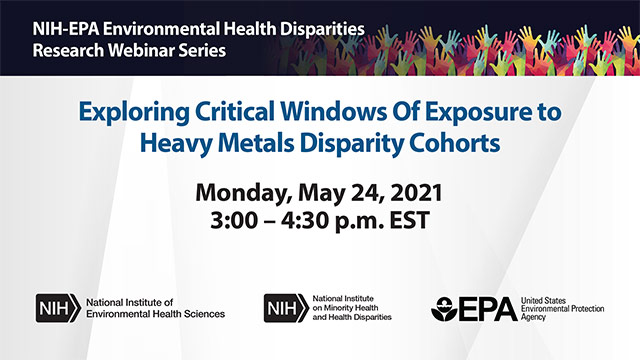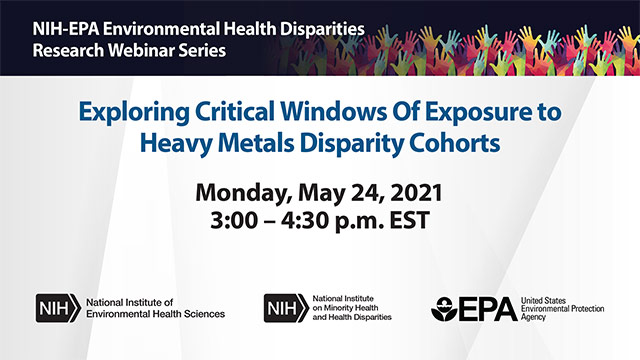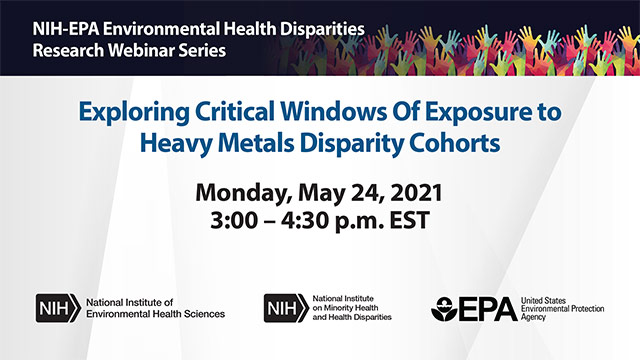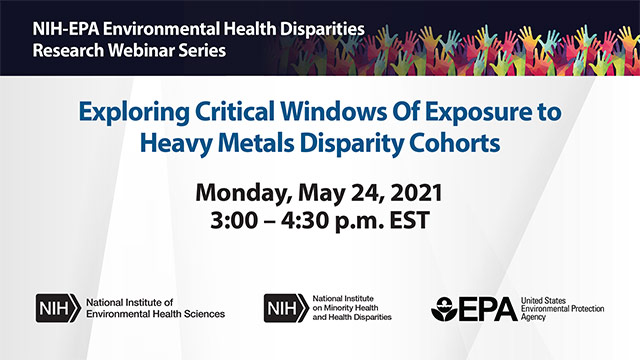Exploring Critical Windows of Exposure to Heavy Metals in Health Disparity Cohorts
Moderators: Carrie Breton, Associate Professor, University of Southern California and Melissa Smarr, Health Scientist Administrator, Population Health Branch, NIEHS
| Time | Event |
|---|---|
| 3:00-3:05 p.m. |
Introduction of Presenters |
| 3:05-3:25 p.m. |
Prenatal Metal Mixtures and Fetal Growth in the MADRES Study |
| 3:25-3:45 p.m. | Immunotoxicological Evaluation of Lifetime Exposure to Heavy Metals in Drinking Water Center Affiliation: Center for Native American Environmental Health Equity Research Presenters: Deborah Keil, Associate Professor, Montana State University |
| 3:45-4:05 p.m. |
Adding Mental Health Outcomes and Socioeconomic Information to Exposure Assessment - a Pilot Study on the Cheyenne River |
| 4:05-4:30 p.m. |
Discussion and Questions & Answers |
NIH-EPA Environmental Health Disparities Research Webinar Series
Part 01 - Intro and Presentation #1

Part 02 - Presentation #2

Part 03 - Presentation #3

Part 04 - Q&A and Closing

Abstracts
Prenatal Metal Mixtures and Fetal Growth in the MADRES Study
Investigators: Caitlin G. Howe1,2; Birgit Claus Henn3; Shohreh F. Farzan2; Sandrah P. Eckel2; Rima Habre2; Brendan H. Grubbs4; Thomas A. Chavez2; Dema Faham2; Laila Al-Marayati>4,5; Deborah Lerner5; Alyssa Quimby6; Sara Twogood6; Micahel J. Richards7; John D. Meeker8; Theresa M. Bastain2; Carrie V. Breton2
1. Department of Epidemiology, Geisel School of Medicine at Dartmouth; 2. Department of Preventive Medicine, University of Southern California; 3. Department of Environmental Health, Boston University School of Public Health; 4. Department of Obstetrics and Gynecology, Keck School of Medicine, University of Southern California; 5. Eisner Health; 6. Cedars-Sinai Medical Center; 7. NSF International; 8. Department of Environmental Health Sciences, University of Michigan School of Public Health
Abstract:
Background and Objectives: Reduced fetal growth increases risk for adverse health outcomes. Metal(loid)s have been associated with reduced fetal growth but have typically been evaluated individually. In the current study, we investigated prenatal metal(loid) exposures, in the context of a complex mixture, in relation to estimated fetal weight (EFW) in mid-pregnancy and birth weight for gestational age (BW for GA) in an environmental health disparity cohort.
Methods: A panel of 21 metal(loid)s was measured by ICP-MS in maternal urine samples collected in early pregnancy from participants in the Maternal and Developmental Risks from Environmental and Social Stressors (MADRES) Study. Mixture-outcome associations were examined using covariate-adjusted Bayesian Kernel Machine Regression (N=188 for EFW, N=262 for BW for GA). Primary analyses focused on elements that have been associated individually with fetal growth in prior studies that were detectable in MADRES (above the limit of detection for 60% of participants). In exploratory analyses, we additionally evaluated metal(loid)s that have been understudied in relation to fetal growth.
Results: In primary analyses, molybdenum and barium ranked most highly as predictors of EFW, and mercury and nickel ranked most highly as predictors of BW for GA. Inverse associations were observed for barium and mercury, while positive associations were observed for molybdenum and nickel. Possible interactions were also identified between molybdenum and barium (EFW) and between mercury and nickel (BW for GA). In exploratory analyses, which investigated a larger mixture of metal(loid)s, these results were robust and antimony was additionally identified as a predictor of reduced fetal growth.
Conclusions: In an environmental health disparity population, we identified potential adverse effects of mercury, barium, and antimony and possible protective effects of molybdenum and nickel on fetal growth when considered as a complex mixture.
Immunotoxicological Evaluation of Lifetime Exposure to Heavy Metals in Drinking Water
Investigator: Deborah Keil, Ph.D., Associate Professor, Department of Microbiology and Immunology, Montana State University, Bozeman, MT
Abstract:
Project Summary and Relevance: The proposed project builds directly on our current P50 Aims 1 and 3 regarding the risk for autoimmune exacerbation from exposure to mixed metals in drinking water as found on Native American tribal lands. Based on our findings to date in both mice and humans, and the current literature, we propose a novel and potentially highly informative approach, based on the idea that the risk from metals exposures is more profound when it occurs throughout life, including the immune developmental periods in utero and early life. Early exposures could set the stage for chronic health outcomes later in life, leading to the observations seen in the DiNEH population. Metals can cross the placental barrier in both mice and humans (ATSDR, 2007; 2012; 2013). Therefore, we anticipate that exposure to metals in drinking water beginning during pregnancy will lead to increased immune dysfunction and autoimmunity that is seeded during early development and expressed later in life. This project will characterize the role of mixed metals in the induction of autoimmune outcomes in wild-type mice, representing a non-genetically predisposed population, and assess developmental effects of fetal and early life exposures. This study has the potential to significantly improve our understanding of mixed-metals exposures, explain health effects being seen within Native American populations who drink metal contaminated water, and support the idea of early life exposure being critical to these health outcomes. This study is highly relevant to the goals and objectives of Center by focusing directly on the original P50 Aims, but with a new approach built on what we have learned so far. Clearly, health effects of metal-contaminated drinking water represent a key rural and Native American health disparity problem due to the disproportionate risk of water contamination seen in water sources for Tribal lands. Further, the nature of the exposure (chronic, low level) and the disease outcomes (chronic, with long latency) create a situation where detection, diagnosis and health care could lag behind what would happen in acute toxicity situations. Using a mouse model allows us to reveal these risks, and thereby improve screening and detection of problems before they become severe.
Specific Aims: This request for a pilot study builds directly on our current P50 Aims 1 and 3 regarding the risk for autoimmune exacerbation from exposure to mixed metals in drinking water as found on Native American tribal lands. Based on our findings to date in both mice and humans, and the current literature, we propose a novel and potentially highly informative approach, based on the idea that the risk from metals exposures is more profound when it occurs throughout life, including the immune developmental periods in utero and early life. Early exposures could set the stage for chronic health outcomes later in life, leading to the observations seen in the DiNEH population.
Significance: This study has the potential to significantly improve our understanding of mixed-metals exposures, explain health effects being seen within Native American populations who drink metal contaminated water, and support the idea of early life exposure being critical to these health outcomes.
Adding Mental Health Outcomes and Socioeconomic Information to Exposure Assessment - A Pilot Study on the Cheyenne River
Investigators: Esther Edrei, Ph.D., University of Mexico
Abstract: There is limited knowledge regarding assessment of metal exposure or risk from the environment among Native people when their reliance on the environment and subsequent increased exposures is potentially modified by additional behavioral and socioeconomic factors. Evaluating participants’ social context, income levels and match these with stress levels and consequent behaviors that bring them in increased contact to their environment would lead to improved exposure classifications. American Indians also experience greater mental health disparities. They suffer from disproportionately increased mental health disorders compared to other Americans. In some states (e.g. Utah), the prevalence of poor mental health conditions, cognitive and visual disabilities are higher for the American Indians than the general population. However, American Indians/Alaska Natives living in the US are less likely to have access to mental health services, therefore, have no mental health diagnosis. In addition, metals have long been suspected to be contributors to mental health conditions as many of them are well-known neurotoxicants (cadmium, lead and mercury). However, new information among humans showed that blood Pb and Cd concentration, even within the acceptable limits for toxicity, were reported to contribute to increased depression and anxiety symptoms. 14 and to the decrease of memory capacity, potentially mediated by low antioxidant defenses. Our hypothesis is that metal exposures and other chemical contaminants originated from environmental injustice and socioeconomic disadvantage would contribute to mental and public health problems, forming at least part of the Indigenous environmental trauma and mental health crisis framework.


